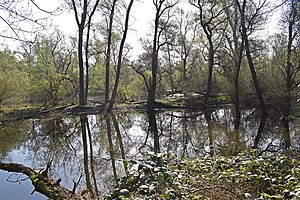Bensheim and Heppenheim clay pits
|
Bensheim and Heppenheim clay pits
|
||
| location | Bergstrasse district , Hesse , Germany | |
| WDPA ID | 82726 | |
| Natura 2000 ID | DE6317305 | |
| Geographical location | 49 ° 40 ′ N , 8 ° 37 ′ E | |
|
|
||
| Setup date | 1977 | |
The clay pit area of Bensheim and Heppenheim is located in the Hessian Ried in the Bergstrasse district between the two towns of Bensheim and Heppenheim . It is a former clay mining area , which has been designated as a nature reserve since 1977 .
location
The nature reserve Tongrubengelände of Bensheim and Heppenheim extends to 91.87 hectares (0.92 km²) between the Meerbach in the south-west of Bensheim and the Jochimsee in the north-west of Heppenheim. The railway line in the east and the A5 motorway in the west delimit the area.
Nature reserve
The “Tongrubengelände von Bensheim and Heppenheim” nature reserve is part of the Natura 2000 protected area system as a fauna-flora-habitat (FFH) area . The area of the nature reserve is identical to the FFH area "clay pit area of Bensheim and Heppenheim". The action plan for the FFH area dated June 25, 2007 describes the conservation objectives for the biotope complexes inland waters (sea meadow ponds, hunting ponds and dead lakes), grassland complexes, reed and reed complexes and bushes and forest complexes.
The nature reserve lies within the EU bird sanctuary "Hessische Altneckarschlingen" (BfN-ID 6217-403), which comprises several sub-areas (4 main sections with a total of 32 sub-areas).
The clay pit area consists of overgrown ponds and reed areas , some of which are overgrown with trees and bushes. It offers valuable biotopes for many rare bird species, amphibians and insects. Caretakers of the Nabu were able to detect up to 90 breeding bird species such as B. Little grebe , pond rail , kingfisher , coot and red kite . There are also food guests such as storks and herons .
Viewpoints
Large parts of the nature reserve are not accessible. There is an observation hut at the hunter ponds in the Heppenheim area, which provides good views of the hunter ponds.
history
Up until about 2000 years ago, the Neckar meandered through the Hessian Ried and flowed into the Rhine north of Darmstadt . The river transported u. a. large amounts of clays that settle in shallow water.
A field fire brick factory was operated as early as 1894 . Industrial clay production by the Tonwerk Heppenheim took place from 1900 to 1960. In 1941 a manufacturing facility was added in Bensheim. During the Second World War, forced laborers kept production in the clay works going. A memorial in Heppenheim on the edge of the site, built in 2018, commemorates the forced laborers.
The excavation pits that were created during the clay extraction were filled with groundwater . Shallow ponds were formed with a lot of reeds and useful biotopes for numerous bird and amphibian species . A land consolidation in 1964 and other structural measures led to the lowering of the groundwater, drainage and silting up of the ponds.
In 1977 the area was designated as a nature reserve, and measures to renaturalize and restore the shallow ponds were initiated. A water inlet structure on the Meerbach in Bensheim was built; It ensures the supply of water and prevents the ponds from drying out. In 1989 the nature reserve was expanded to its present size and legally designated as a nature reserve.
Web links
Individual evidence
- ↑ DE-6317-305 clay pit area of Bensheim and Heppenheim (FFH area). Published by the Federal Agency for Nature Conservation .
- ↑ Darmstadt regional council: Action plan for the FFH area clay pit area of Bensheim and Heppenheim. (PDF) Darmstadt Regional Council, June 25, 2007, accessed on April 18, 2020 .
- ↑ a b c bio-plan: Basic data acquisition for monitoring and management of the FFH area 6317-305 "Clay pits of Bensheim and Heppenheim". October 2004, accessed May 7, 2020 .
- ↑ J. Kreuziger, M.Werner: SPA monitoring report for the EU bird sanctuary 6217-403 "Hessische Altneckarschlingen" (Darmstadt district). March 2017, accessed May 7, 2020 .
- ↑ What is creeping and fleeing there? In: Bergstrasse Anzeiger . March 30, 2020.
- ↑ a b Unique nature reserve . In: Bergstrasse Anzeiger . 29 May 2019.
- ↑ The rise and fall of the Tonwerk . In: Bergstrasse Anzeiger . August 16, 2014.
- ↑ Heppenheimer Tonwerk. In: Archive of historical roof tiles. Roof tile archive (www.dachziegelarchiv.de), accessed on April 18, 2020 .
- ^ Memorial for forced laborers in Heppenheim. (PDF) Nibelungenland learning landscape, accessed on April 18, 2020 .


